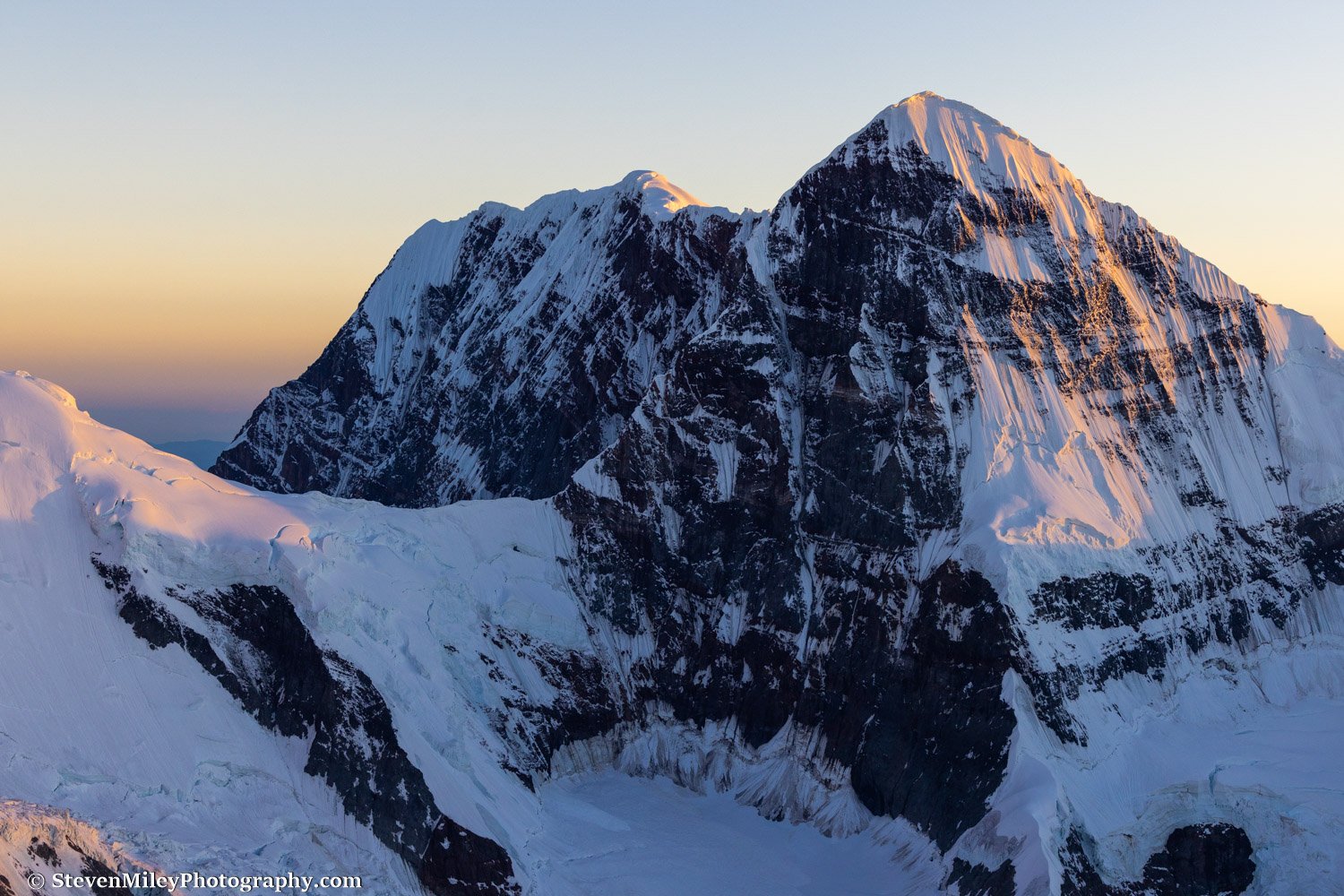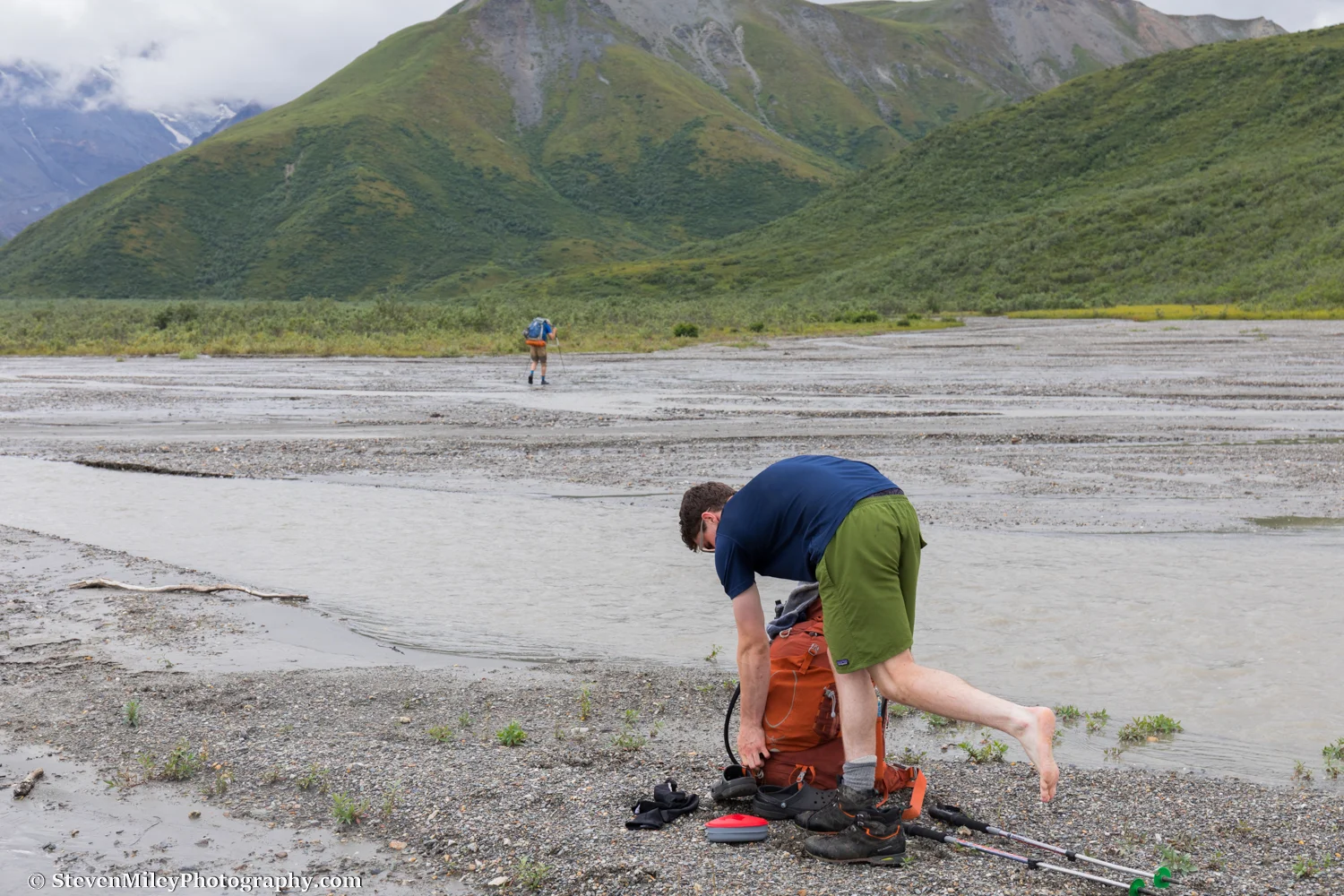Trident Glacier icefall under twilight.
I’ve visited the Hayes Range on the west side of the Delta River every summer since 2016. Last August I opted to fly in so I could spend more time photographing and less time struggling to cross the Delta and navigating through soggy tundra. Golden Eagle Outfitters dropped me off at a remote airstrip near Trident Glacier around sunset and I took my very first professional-quality aerial shots of the big peaks of the Hayes Range during the flight.
Mount Deborah at sunset. The famous E ridge rises from the col left of center.
After the plane took off I started hiking quickly to knock out a few miles before dark. As I walked along a muddy creek adjacent to Trident Glacier I passed countless fresh tracks belonging to bear, wolf, moose, caribou, fox, and other animals. Mount Moffit loomed directly ahead, growing larger with every step. As the twilight faded I pitched my tent near some rocky outcroppings. I awoke shortly before sunrise and climbed atop a big rock for a signature selfie with my camera operating on a timer.
Mount Moffit at sunrise with Trident Glacier below. I had great cell service from this location.
Something that drove me crazy about my old Canon 5D Mark IV was its inability to shoot with either live view or mirror lockup enabled while using the built-in interval timer. This made it difficult to avoid blur caused by mirror slap when shooting similar images with a telephoto lens using the interval timer. I shot the above image using the Canon R5, which still has the same interval timer as the 5D Mark IV except it’s now possible to use the interval timer in conjunction with the electronic shutter which avoids vibration from mirror slap or shutter shock. Sony cameras have a built-in interval timer that puts Canon’s to shame in terms of user-friendliness and functionality, and I really wish Canon would refine theirs.
After sunrise, I leisurely strolled farther up the creek parallel to Trident Glacier. After a couple miles, the creek bent away from the glacier into a vast valley, and cliffs above the glacier’s edge blocked the path forward. I descended onto the glacier there and slowly navigated across its nearly two-mile width. I lost one of my Microspikes on the way, so I had a terrible time scrambling up and down over the dozens of steep hills on the glacier.
One of countless interesting sights on Trident Glacier.
On the far side of the glacier I scrambled up a steep slope onto a bench where I had hiked previously on my traverse from Black Rapids to Healy in 2018. The last time I was there, rain was falling hard and I could only see the bottom portion of Mount Moffit. This time, the majesty of the mountains was on full display. I bushwhacked for a short stretch following a rough game trail until the brush thinned. After that, I strolled through some of the easiest hiking terrain the Alaska Range has to offer while winding around a wide bend in the glacier. I surprised a porcupine hanging out in the open and it waddled away from me at a glacial pace until it found a bush to hide in.
Trident Glacier with Mount Moffit (right) and McGinnis Peak (left, above icefall).
My arctic ground squirrel buddy.
I found an area of soft, flat tundra to place my tent with a ridiculous view of Mount Moffit and an eyepopping icefall just around the corner. The wind never seemed to blow there, and the white noise from a nearby creek was soothing. The only drawback to this perfect campsite was one pesky arctic ground squirrel who enjoyed nibbling on my tent. Nearly all of the squirrels I see while hiking in remote areas keep their distance from me or dive into a hole under the ground when I approach, but this one would hop close to me to investigate my pack and tent, and it wouldn’t scurry away unless I stood up or moved toward it quickly, just like the Denali National Park squirrels. I did appreciate it posing nicely for photographs, though.
After the first night at camp, enough smoke from distant wildfires had drifted into the area to cause a slight haze—not enough to totally ruin all my landscape photos, but enough to be annoying. I climbed a ridge with nonstop views of the mountains and Trident Glacier until I could see Donnelly dome to the northeast. A herd of roughly 100 caribou appeared over a neighboring ridge but they remained too distant for a good photo. Below, I spotted a few people hiking on Trident Glacier resembling ants crawling on a runway. They must have been the group my pilot told me he was picking up the next day.
I hung out on the ridge photographing and enjoying the warm weather until the clouds turned threatening. The rain held off long enough on my hike back to camp for me to collect water, photograph some wildflowers and watch a few caribou roaming nearby, but as soon as I reached my campsite steady rain began falling. I crawled inside my tent and the rain quickly intensified, falling heavier than any rain I’d previously experienced in the Alaska Range. Lightning began flashing every minute and thunder crackled a second or two after each flash. I nervously huddled in my tent waiting for the thunderstorm to subside, hoping my tent would withstand the driving rain.
Mount Hayes obscured by clouds at the head of Trident Glacier.
After 10 or 15 minutes the lightning grew less frequent and the rain slowed to a gentle patter on the tent. After another few minutes the rain stopped completely. The small creek nearby sounded like a raging river after the storm passed. I fell asleep and awoke the next morning to the sound of that squirrel nibbling on my tent.
Summit of Mount Moffit.
Clouds over Trident Glacier were still clearing when I exited the tent, slowly revealing the summit of Mount Moffit. After an hour, all the clouds had disappeared, and I began climbing higher than I did the previous day along the same ridge. I passed a couple caribou on my way above 6000 feet elevation, where the ridge turned to rock. I surveyed several potential locations for a selfie sunset shot and settled on a wide shot with some large rocks in the foreground, though there were so many other options and I regretted only being able to choose one. While the shot I picked came out nicely (see below), I took a better one on the fly soon after just before the last flash of sun faded a single rock pedestal sticking out high above Trident Glacier. I took another favorite shot of the icefall glowing softly under the twilight on the hike back down the ridge some time after sunset. (First image in this post.)
The next day I packed up all my gear and crossed back over Trident Glacier, which was still a pain due to my lost ice cleat but much easier than the initial crossing since I knew where to avoid the worst obstacles. While waiting for my pilot, a lone bull caribou wandered aimlessly around the landing strip, and for a moment I thought I might have to chase it off when the plane came in for a landing. After flying home, I laughed when I realized I had only hiked 15 miles total. Flying in and out freed up so much time for me to focus on photography, and I didn’t have to fight exhaustion to stay up late for sunset or wake up early for sunrise at all this trip. Feels a bit lazy, but I could get used to it.
Somewhere around 6000 feet elevation on a ridge above Trident Glacier opposite Mount Moffit.




















